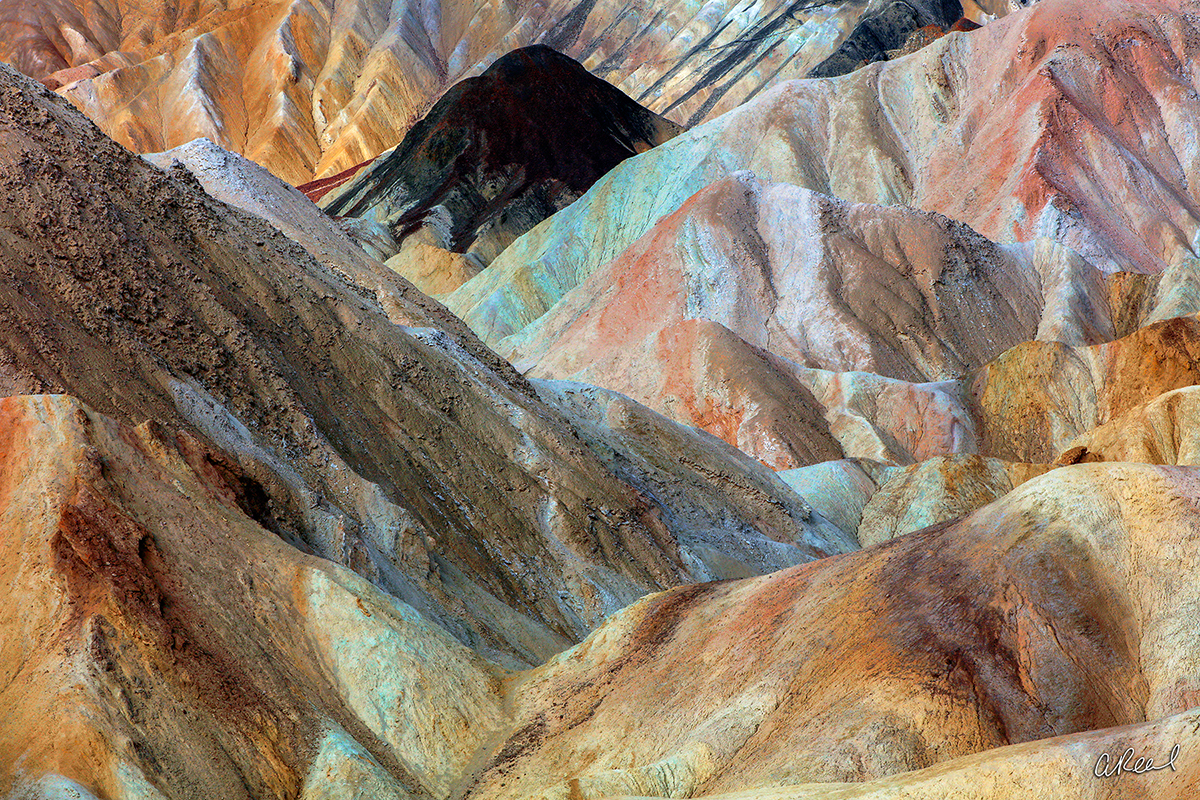Deep in the Deserts of Death Valley
Aaron Reed captures the surprising colors, contrasts, and textures of one of the hottest spots on Earth with his Tamron SP 70-200mm VC G2 lens.
More Photo Tips | Video Gallery | Photo Gallery | Enewsletter sign-up
By Jenn Gidman
Images By Aaron Reed
In 2008, Aaron Reed purchased an MP3 player for the first time, which meant he no longer needed his CD collection. He wanted to sell his discs, but he had to put photos of them on eBay to make the ad more attractive. So he bought an inexpensive point-and-shoot camera, went to the beach that evening to test it out, and had so much fun doing so he decided, that night, he wanted to become a photographer.
A decade later, Aaron has cultivated a following for his landscape and nature fine-art photography, and he teaches individual and group photo workshops. The Sammamish, Washington, photographer is drawn to two particular types of photos in his genre. "You've got what I call the obvious compositions, like if you're going to Yosemite and have Half Dome in front of you," he says. "That's the type of photo everyone tries to capture, because it's a composition that just organically pops out at you."
On the other side of the spectrum, Aaron breaks down the wider landscapes into discrete sections he then turns into abstract images. "That's the type of photography that's the most fun and challenging for me," he says. "My fine-art clients gravitate toward that more-generalized photography, where the concentration is on colors, lines, and textures."
In Death Valley, where Aaron recently ventured, he found the best of both worlds. "When I choose places to travel to for my photography, I try to pick locations where I can capture both types of images—the wide-angle, easily identifiable compositions, and then the abstracts that might appeal to my customers looking for fine-art prints," he says. "I want to get the best bang for my buck while I'm there and also capture photos that will do well for me commercially."
On his trip, Aaron brought along the Tamron SP 70-200mm VC G2 lens, which he supplemented with a 2x teleconverter. "The versatility the lens offers is ideal for a place like Death Valley, where I might want to capture a sweeping landscape in one instance, then zoom in for a more detailed abstract the next," he says. "The focusing ring operates very smoothly, which is a definite plus with a telephoto lens like this, and I appreciate the sleek, black design and easy grip it offers as I'm trudging over the dunes."
Aaron traveled to Death Valley in February, when it was a very manageable 68 degrees to 72 degrees during his stay. "If you went during the summer, it would be 120 degrees," he says. "You would definitely not want to be out there in that, whether you were dragging gear around or not. The sand and dust weren't too bad when I visited, as long as the wind didn't kick up. I've known photographers who were out there during storms, when the wind was blowing at 40 mph, and they ended up walking out with sand in their teeth. If the forecast is for a windstorm, you should make sure you wrap all of your equipment in plastic to minimize the potential for damage."
It was Aaron's first trip to Death Valley, which meant he captured what he believes may end up being some of his best photos there. "I find when I visit a location for the first time, that's when my images really tend to shine—even if I go back 10 times after that," he says. "I don't know if it's the excitement of being somewhere for the first time, or maybe not having any preconceived notions of what I should photograph and having an open mind, but I'm almost always pleased with the pictures I come back with from a first visit."
Aaron took all of the photos shown here at Zabriskie Point, a popular gathering spot for photographers and which many may recognize as the landscape used on the cover of U2's The Joshua Tree. "This vantage point allows you to look straight across at all of the mountains, but you can also see the whole valley floor as well," he says. "There are plenty of photographic opportunities at your disposal in this location."
What Aaron was specifically looking for among the Death Valley peaks and valleys: shapes, textures, patterns, and—perhaps most important—colors. "About 99 percent of my landscape fine-art work is in color, though occasionally I'll try to 'save' an image by converting it to black and white if I took it in midday and the color contrasts I'm looking for are lacking," he says. "The colors I find and emphasize are important, because even though some of my images might appear similar to many people, the color schemes are all slightly different. People looking to buy my work in large prints are often looking specifically for colors that match their home decor."
Some people can't believe Aaron is able to capture such eye-catching colors in his photos, as evidenced in his "Liquid Rainbows" image. After all, aren't deserts dry, brown, and devoid of chromatic differentiation? "People who think that are usually the ones out in Death Valley during times when they wouldn't see these colors," he explains. "The ideal time to get out there is before the sun has even risen, like I did for 'Waves of Eternity.' That soft early light brought out the pleasing combination of soft oranges, yellows, and reds in the hills."
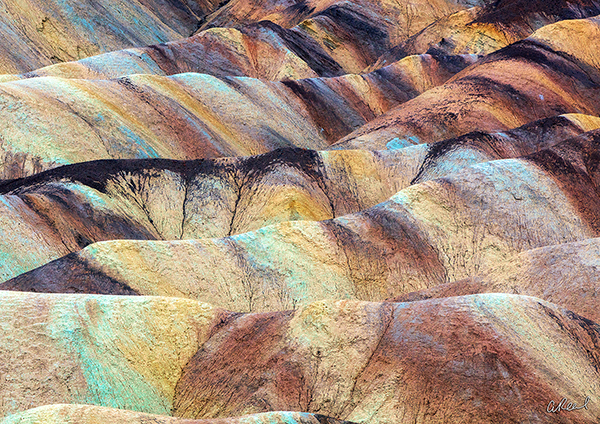
326mm, F/11, 0.5 sec, ISO 400
Click image to view larger
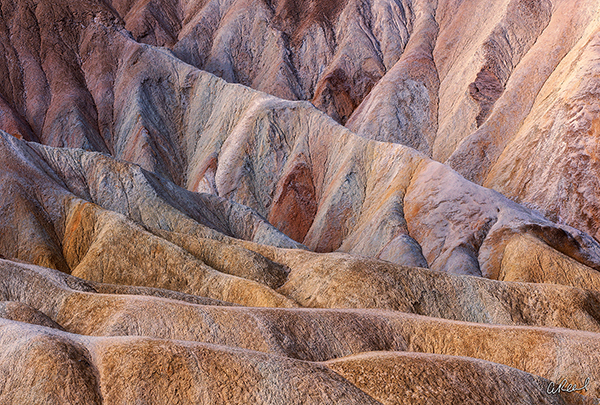
118mm, F/16, 1/60th sec., ISO 100
Click image to view larger
Once the sun is too high in the sky, it eradicates all the stunning colors and contrasts from the sand, which is when Aaron transitions to scouting mode. "During the peak-sun part of the day is when I look for scenes I can return to at a later time, or early the next day," he says. "I also have plans to do a photography workshop in Death Valley, so on this trip I wanted to cull as many possible shooting locations as I could for that."
The gradual gradation of earth tones people associate more closely with desert scenes can also draw visual interest. "'Peanut Butter Crunch' is a good example of that," Aaron says. "The colors start out darker up top and lighten up as your eye moves toward the bottom of the frame, where all of those cracks and lines eventually converge. The same for 'Cracks in the Earth': I wanted to show the contrasts in between the colors in the upper third of the photograph and then the more muted browns in the valley in the lower two-thirds. Overall, what I'm trying to do as a photographer is to make my compositions so that your eyes don't have a reason to leave the image. As a viewer, your eyes will typically wander through a photo, but then, hopefully, if I've done my job, you'll circle back and look some more, rather than move off the page—all too common in these days of easy distraction."
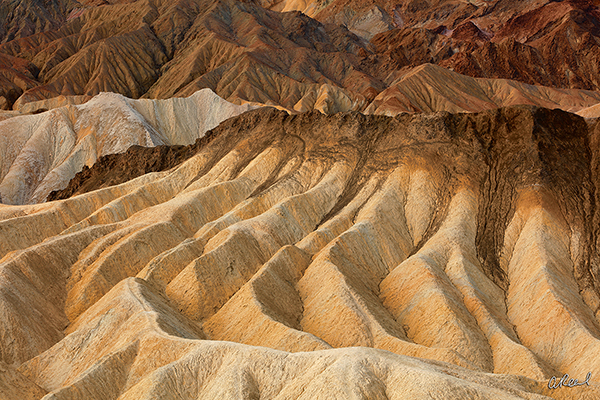
100mm, F/16, 1/20th sec., ISO 100
Click image to view larger
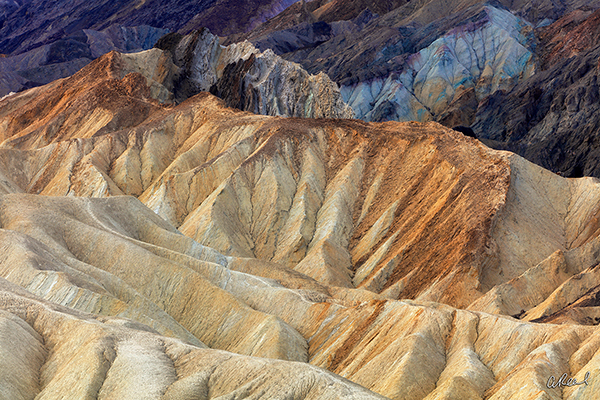
213mm, F/16, 1/30th sec., ISO 100
Click image to view larger
Being ready to capitalize on uncommon conditions is also key to capturing uncommon images. "It's almost always sunny in Death Valley," Aaron says. "In the Pacific Northwest, I can pretty much shoot all day because of the fairly regular cloud cover; Death Valley is a different story. And because it's rare to see clouds in the sky, you're not going to get many photos with dramatic clouds in your photo."
That's why Aaron was pleased to capture "Ripples in Time," which he deems his favorite composition from the Death Valley photos here. "That one turned out really beautifully because it had rained the night before, which doesn't happen often," he says. "So the next day presented me with remnant clouds. Most of the area was in shadow, but then shafts of light would poke through. It gave the image I eventually captured some extra dimension."
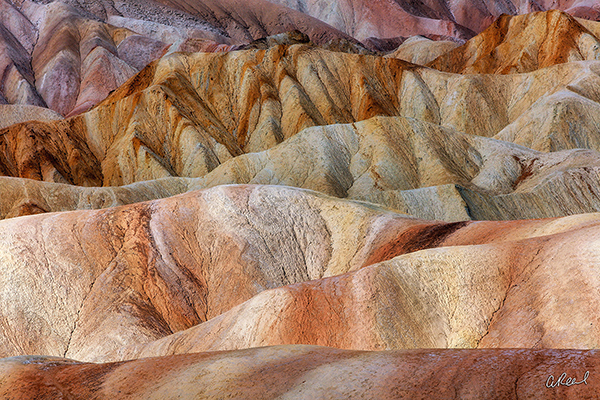
Click image to view larger
One tool that helps Aaron draw out the details in Death Valley is the 2x teleconverter he uses with his 70-200 G2. "The teleconverter opens you up to a whole new world, especially in an area like Death Valley where there's this big, vast landscape and not a whole lot of easily identifiable subjects," he says. "Without the teleconverter, you're just seeing abstracts of rolling hills. When you put the teleconverter on and scan the hillside, however, all kinds of wonders pop out at you, and they help drive your compositions. There are many details you likely wouldn't see without it."
The teleconverter also helps get rid of a potentially distracting element: footprints. "To avoid getting those in your shot, you have to walk out farther than everyone else, or you have to use a teleconverter," Aaron says. "I was able to photograph at an angle across the sand and reach places where no one was walking. Otherwise, I would've ended up having to Photoshop out a thousand footprints, which would've been time-consuming."
Aaron cites his "Watercolors Web" photo as one example of when the teleconverter came into play. "I love the whole scene here, how the layers all kind of fold into themselves in a kind of zigzag pattern," he says. "The teleconverter allowed me to reach farther up into the hills than I could have without it. As for that black-shaded hill in the upper center of the image, I don't know why it's that color—it was the only hill like that in the entire area—but it was perfect to have it situated right in the middle of all those other colors."
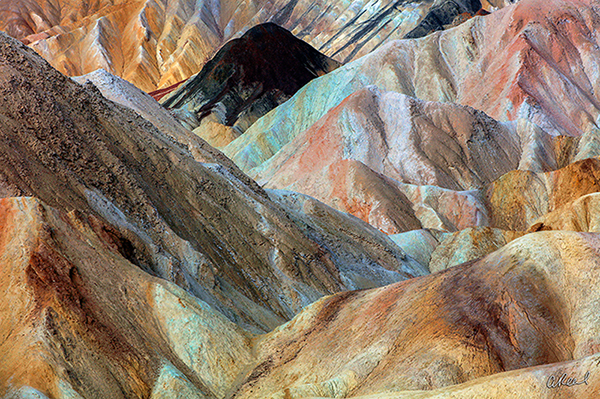
289mm, F/16, 1/180th sec., ISO 100
Click image to view larger
Aaron's post-production workflow is a four-step process. "First there's the clean-up work, which involves getting rid of any type of dust spots or specks and adjusting the general exposure to balance highlights and shadows," he says. "The second step is adding contrast. I always add contrast first, because contrast affects color."
Next come the color corrections. "I'm really big on colors coming through as they really are," he says. "I know some photographers like their images to look consistent in terms of all having a reddish or bluish cast, but I like colors to stand on their own. Every once in a while I'll bump up saturation in certain areas or isolate just certain colors, like the reds; I don't ever apply a sweeping color correction to the whole photograph. My final step: adding a bit of lightening or darkening here and there. From there, I'm ready to create files in different sizes for print so people can start ordering!"
To see more of Aaron Reed's work, go to www.aaronreedphotography.com.
More Photo Tips | Watch Videos | Learn More About Tamron Lenses | Photo Gallery
